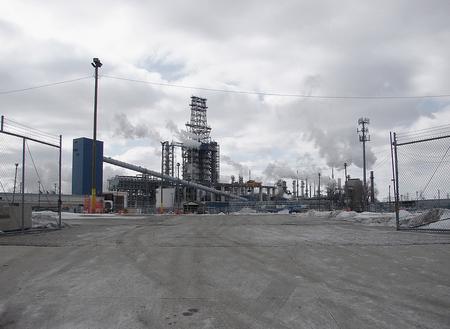Expand Your Environmental Understanding with WDET’s Earth Week Glossary
In honor of Earth Week, take a deep dive into several environmental terms that you’ve likely heard, but may not fully understand.

From green infrastructure to regenerative agriculture, explore the origins and significance of some key environmental terms and hear from a few folks doing the work locally.
CSA (community supported agriculture)

Dazmonique Carr is the co-founder of Detroit’s Deeply Rooted Produce, which offers a CSA program. “We’re letting people buy into the shares of our operation, and in exchange for their money, they’ll get produce either weekly or biweekly,” she explains.
The origins: According to a 1993 excerpt from a text titled “Community Supported Agriculture (CSA): An Annotated Bibliography and Resource Guide,” community supported agriculture is a relatively “new idea in farming, one that has been gaining momentum since its introduction to the United States from Europe in the mid-1980s. The CSA concept originated in the 1960s in Switzerland and Japan, where consumers interested in safe food and farmers seeking stable markets for their crops joined together in economic partnerships.”
In 1975, a farmer named Yoshinori Kaneko in Japan realized that he could also supply food like rice, wheat and vegetables to other families in return for money and labor. This was how the concept of CSA initiated in Japan.
In his 1987 book, “How To Make $100,000 Farming 25 Acres,” horticulturist and author Booker T. Whatley explored his 10 commandments of farming, one of which is the importance of the “Clientele Membership Club.” Members paid an initial fee, which contributed to the success of the farm. In return, they received fresh produce that they would pick themselves. Whatley identified this as an essential aspect of a successful farm in the 1960s and ’70s, and today, this idea is commonly referred to as a CSA.
The context: In 1870, 70-80% of the U.S. population was employed in agriculture, so if you were not a farmer, it was likely that you knew several, and knew which farmers were growing the food that you ate, according to Michigan State University Extension. By 2008, that number had fallen to less than 2% of the U.S. population who were directly employed in agriculture. That drastic drop of American farmers had led many American families to lose connection with the people who grow their food.
During the late ’80s and early ’90s, some farmers and consumers decided that they wanted an alternative to the national and global food system and adopted a new model for getting fresh produce.
Where to get it locally: CSAs rose in popularity even more in the last year as the pandemic prompted more people to try to find ways to obtain fresh food while limiting time in grocery stores. There are many CSA options in and around Detroit. A few include Deeply Rooted Produce, City Commons and Fisheye Farms.
Green Infrastructure
The definition: According to the EPA, green infrastructure is “…the range of measures that use plant or soil systems, permeable pavement or other permeable surfaces or substrates, stormwater harvest and reuse, or landscaping to store, infiltrate, or evapotranspirate stormwater and reduce flows to sewer systems or to surface waters.”
Here’s how Joel Heeres, Director of Sustainability for the City of Detroit, defines it: “Green stormwater infrastructure are nature-based solutions that naturally detain and or infiltrate rainwater into the ground naturally, thereby reducing the load on the combined sewer system, reducing the probability of sewage overflows into local waterways.”

Heeres explains that as a term “green infrastructure” is used very broadly and can more generally describe ‘the use of nature-based interventions to reduce emissions, improve air quality and quality of life for transportation, stormwater management and building operations.'”
The benefits: The EPA says “green infrastructure is a cost-effective, resilient approach to managing wet weather impacts that provides many community benefits.” One of the benefits of green infrastructure compared with single-purpose gray stormwater infrastructure — conventional piped drainage and water treatment systems that is designed to move urban stormwater away from the built environment — green infrastructure reduces and treats stormwater at the source.
Some examples of green infrastructure include:
There are many local efforts to create more robust green infrastructure in Detroit and there are ways to get involved with Detroit climate efforts during Earth Week 2021.
Why it matters: The EPA states on its website that “climate change is affecting us now. As different parts of the country become drier, wetter or hotter, green infrastructure can help improve community resiliency today and into the future.”
Environmental Justice
The definition: EPA defines it as “the fair treatment and meaningful involvement of all people regardless of race, color, national origin, or income, with respect to the development, implementation, and enforcement of environmental laws, regulations, and policies.”
Why it matters: Environmental justice gives people a chance for meaningful involvement when making choices and designing policies that impact health and quality of life. Here’s what meaningful involvement looks like, according to the EPA:
- People have an opportunity to participate in decisions about activities that may affect their environment and/or health;
- The public’s contribution can influence the regulatory agency’s decision;
- Community concerns will be considered in the decision-making process; and
- Decision-makers will seek out and facilitate the involvement of those potentially affected.
The role of equity is crucial in this idea, which is why the City of Detroit is making strides toward addressing environmental justice locally with the creation of a Climate Equity Advisory Council. It was created in “partnership with Detroit City Council’s Green Task Force, led by Councilman Benson, to help [city officials] work alongside Detroiters to resume public outreach and engagement.” The council comprises longtime environmental justice activists and sustainability leaders who have been working on climate solutions for years.
The local context: There are many areas of concern for environmental justice advocates in Michigan. Some of the biggest include the Flint Water Crisis, which centers on the legacy impact and circumstances that allowed lead-tainted drinking water to be distributed to low-income communities of color living in that city; along with air pollution in Southwest Detroit and other neighborhoods in and around intensive industrial zones.
According to the nonprofit Detroiters Working For Environmental Justice, the Michigan Department of Health and Human Services, in a 2016 study, “not only found that the rate of adult Detroiters with asthma was 29 percent higher compared to the rest of the state but that the rate of asthma hospitalizations was 3x higher as well.” The study also concluded that asthma rates in adult Detroiters was significantly higher than the rate for children in the city, a sign that the chronic condition was most likely the result of long-term exposure to adverse environmental conditions.
Pollution in Detroit has historically come from multiple sources like factories, steel mills, power plants, waste incinerators, vehicle exhaust and oil refineries. “These and other sources of pollution have contributed to low air quality, while contaminated wastewater, manufacturing discharges, leaks and dumping, as well as oil and chemical spills and runoff have resulted in water contamination,” according to DWEJ. “Industrial activities, dumping of chemicals and manufacturing waste, and other pollution sources also led to widespread soil contamination with numerous toxic sites and ‘brownfields’ across the city.”
Regenerative Agriculture
The definition: “Regenerative agriculture is a system of farming principles and practices that increases biodiversity, enriches soils, improves watersheds and enhances ecosystem services,” according to Terra Genesis International. Regenerative agriculture aims to reverse global climate change by capturing carbon in soil and biomass.
“The goal of regenerative farming is to farm and ranch in nature’s image,” says Gabe Brown, a North Dakota farmer and author of Dirt to Soil. In a recent story in the publication Natural Awakenings, he offers six principles to create a thriving, regenerating agricultural ecosystem.
- Context
- The least amount of mechanical and chemical disturbance possible
- Armor on the soil
- Diversity
- A living root being in the soil as long as possible throughout the year
- Livestock and insect integration
The context: Regenerative agriculture traces its roots to Indigenous people, who have long protected local ecosystems and preserved biodiversity through a variety of land management and farming practices. Even the term is considered problematic by some as it just gives a new name to land-tending traditions that have been practiced by Indigenous people for millennia.
Sierra Clark, an Odawa and Anishinaabe journalism fellow with the Traverse City Record-Eagle and Indigenizing the News offers the following perspective on the term: Regenerative agriculture is not a new concept to me as an Anishinaabe Kwe. My ancestors are the original stewards here (in Michigan) and we have continued to be so. Our teachings are deeply rooted in having respect and honor for all walks of life, which include our plant and tree relatives. I recognize the need for our society to reconnect with the land and water, and hope this concept helps encourage non-Indigenous to be good stewards for the land they occupy. We must all come together to entrust a good future for the next seven generations.
Who is doing it locally? Verdant Hollow Farms in Southwest Michigan has implemented regenerative methods. Farm manager Molly Muchow told Local 4 News earlier this month that she and her husband, Brett, wanted to restore the “soils, forests and wetlands.”
“The previous landowner of the farm had raised livestock for many years on the property, however, at some point in the last decade they began leasing the ’tillable’ acreage to someone who grew conventional soy and corn,” she explains. “We had the benefit of moving to the farm without a background in conventional agriculture (Brett was a teacher, and I was a chef) and knew that we wanted to somehow restore the soils, forests, and wetlands at Verdant Hollow. After working with a permaculture design team (Peter Bane and Keith Johnson) we came to realize that the best way to do this would be through multi-species livestock rotation.”
There are many organic farmers in Detroit engaged in regenerative land tending and food cultivation, but it’s important to remember that not all organic farming is regenerative.
Trusted, accurate, up-to-date
WDET is here to keep you informed on essential information, news and resources related to COVID-19.
This is a stressful, insecure time for many. So it’s more important than ever for you, our listeners and readers, who are able to donate to keep supporting WDET’s mission. Please make a gift today.


